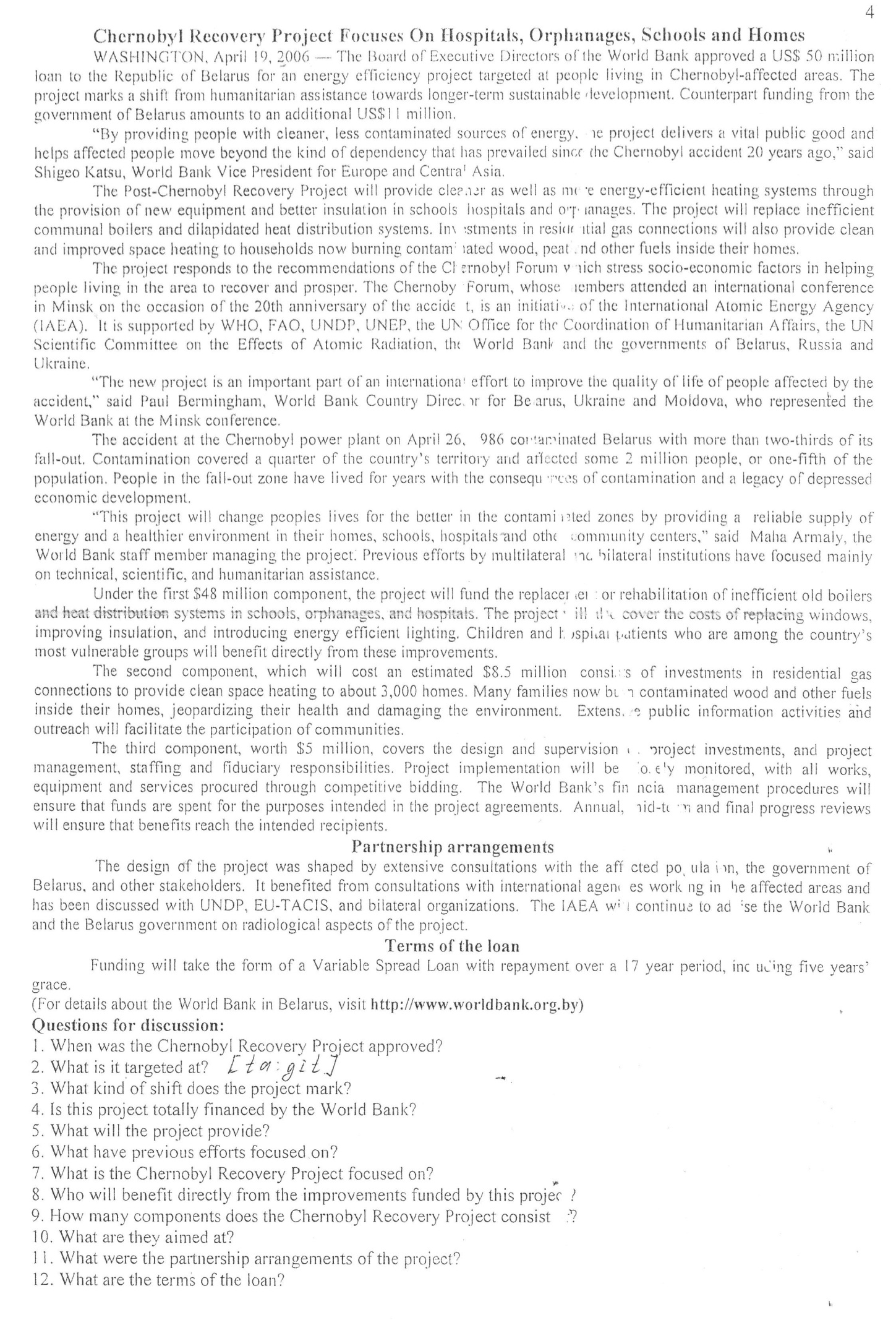
Going Forward
The World Bank's Country Assistance Strategy for Belarus of December 2007 envisaged financial assistance to improve people's livelihoods through investments in social and public infrastructure, as well as the support for global public goods such as investments in emission reductions. The Bank maintains a limited and selective presence in lending with about US$100 million a year in long-term loans over the next four years.
In an early 2009 a US$ 125 million loan is planned to finance the conversion of heat-only-boilers to combined heat and power plants across the country, thus improving energy efficiency and reducing carbon emissions.
The Bank continues as a leading external source of economic and social analysis and a facilitator in discussing policy choices within the country. The Bank focuses its analytical work on needed structural reforms and on those issues most critical to reducing the risks to the population posed by transition and external shocks. The new Country Economic Memorandum (under preparation) considers reforms needed to boost productivity, competitiveness, and export diversification. Contact Information: website: http://www.worIdbank.org.by
Questions for discussion:
What are the aims of the Belarus Post-Chernobyl Recovery Project?
What are the three project components?
What is the program "Chistaya Voda" aimed at?
What are the three components of this program?
When did Belarus become a member of the World Bank?
What are the results of the recently completed Social Infrastructure Retrofitting Project?
What is the aim of the Water Supply and Sanitation Project?
What two projects are currently under implementation?
What kind of additional assistance does the World Bank Group provide to the Government of Belarus?
What was the World Bank's Country Assistance Strategy for Belarus of December 2007?
What is a US$125 million loan planned to finance in an early 2009?
What does the Bank focus its analytical work on?
What does the new Country Economic Memorandum consider?

Taxation
to levy - взимать налоги (облагать);
to impose - облагать налогом;
tax burden - налоговое бремя;
benefit-received principle - принцип извлечения выгоды;
ability-to-pay principle - принцип платежеспособности;
to afford smth. - позволять себе что-либо,
sales tax - налог с оборота;
value-added tax - налог на добавленную стоимость;
income tax - подоходный налог;
property tax - налог на собственность;
inheritance tax - налог на наследствo
The principal purpose of taxes is to pay for the cost of government. Sometimes taxes are levied to protect selected industries. The federal government can use its ability to tax to regulate the level of economic activity.
Taxes may be imposed on transactions, institutions, property and all kinds of other things. But the most important thing is that taxes are paid by people.
All taxes are paid out of income. Two principles of taxation deal with the equity in distributing tax burdens.
The benefit-received principle of taxation states that those who benefit from government programme are the ones who ought to pay for it.
The ability-to-pay principle states that taxes ought to be paid by those who can best afford them, regardless of the benefits they receive.
Most taxes can be classified as progressive, regressive and proportional. A progressive tax takes a larger percentage of a higher income and a smaller percentage of a lower income.
A regressive tax is one that takes a higher percentage of a low income and a lower percentage of a high income!
A proportional tax takes the same percentage of all incomes, regardless of size. A sales tax is a general tax levied on consumer purchases of nearly all products. Sales taxes have a regressive effect. A value-added tax is similar to a sales tax and is also regressive. An income tax, a property tax and an inheritance tax are progressive taxes. Much of the government's revenue comes from the income and property taxes.
Ex. 1. Match the English words with the appropriate Russian equivalents:
purpose способность
to protect получать выгоду, прибыль
level заявить, сообщить
ability цель
distributing уровень
purchase защищать
transaction доход
to benefit покупка
to state распределение
сделка
Ex2. Say whether these statements are right or false:
The principal purpose of taxes is to pay for the cost of government.
Taxes are paid by the government.
There are three principles of taxation.
The benefit-received principle of taxation states that those who benefit from government programme are the ones who ought to pay for it.
A progressive tax takes a smaller percentage of a higher income and a larger percentage of a lower income.
A regressive tax is one that takes a higher percentage of a low income and a lower percentage of a high income.
A proportional tax takes the largest percentage of all incomes, regardless of size.
A sales tax is a general tax levied on consumer purchases of nearly all products.
Much of the government's revenue comes from the income and property taxes.
Ex.3. Answer the questions:
What is the main purpose of taxes?
What may taxes be imposed on?
Who pays taxes?
What are the principles of taxation?
What does the benefit-received principle state?
What does the ability-to-pay principle mean?
How can most taxes be classified?
What is a progressive tax?
What is the peculiar feature of a regressive tax?
What is a proportional tax?
What are the examples of progressive and regressive taxes?
Ex. 4. Complete the sentences:
The principal purpose of taxes is...
The federal government can use its ability to tax...
Taxes may be imposed on...
But the most important thing is...
Two principles of taxation deal with...
The benefit-received principle of taxation states...
The ability-to-pay principle states that taxes ought to be paid...
Most taxes can be classified...
A progressive tax takes a larger percentage of a higher income and...
A regressive tax is one that takes...
A proportional tax takes...
A sales tax is a general tax levied...
A value-added tax is similar...
Much of the government's revenue comes...
Ex. 5.Make up a plan of the text and retell it.
